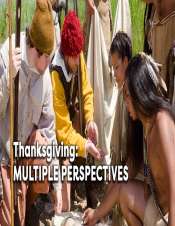
Objectives
- Students will explore multiple perspectives about Thanksgiving celebrations in Plymouth, MA.
- Students will create a landmark that commemorates both the European Settlers and the Native American viewpoints concerning the Colonizing of America.
Materials
- Copies of A Not-So-Traditional Thanksgiving
- Paper
- Pencils
- Colored pencils
- Art supplies with which students can create landmarks (optional):
- Modeling clay
- Shoe boxes
- Feathers
- Canvas
- Paint
Procedures
- Distribute copies of A Not-So-Traditional Thanksgiving .
- As students read the article, ask them to keep a list of facts they learn from the handout that are new to them.
- Conduct a class discussion about the situation in Plymouth using the following questions:
- Why did Plymouth become "America's Hometown"?
- Does this tell you anything about the way American history is formed? If so, what?
- Why are Native Americans upset about the Plimoth Plantation and the Pilgrim Progress procession?
- What is the National Day of Mourning?
- What actions have the United American Indians of New England (UAINE) taken to commemorate the National Day of Mourning?
- Why don't the people of the Plymouth Historical Alliance change their depictions of the first settlers and Thanksgiving to appease UAINE? What would they argue is valid about their point of view?
- What is the symbolism of Plymouth Rock and why do the members of UAINE bury it each year?
- What do you think about this issue? Can you suggest ways for them to resolve the situation?
- Ask students to create their own landmarks commemorating both sides of the issue. They may either draw an illustration of their proposed landmark or create a small-scale model of itusing various art supplies.
- Have each student present his landmark, along with an explanation of its symbolism, in front of the class.




